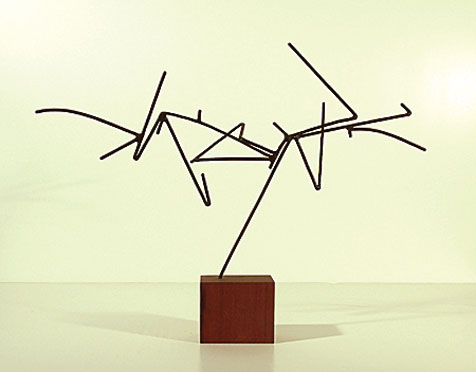Sidney Gordin: Russian-American Constructivist
At Sullivan Goss, An American Gallery. Shows through April 27.

Sullivan Goss continues to explore the cultural legacy of 20th-century emigres to California in this exhibition of the work of distinguished sculptor, painter, and art professor Sidney Gordin. Born into the tumult of the Bolshevik Revolution, Gordin moved from Russia to Brooklyn, New York, in 1922 at the age of four. Gordin left New York in the late 1950s to take a teaching position at UC Berkeley, where he remained for three decades. This show pieces together the disparate styles and media of a vigorously talented man who managed to maintain allegiance to the principles of Russian Constructivism while changing along with the dynamic environment of the American art scene.
Gordin’s most original contributions to 20th-century art are his sculptures, several of which are on display. Constructivism claimed to provide a wholly new way of perceiving space, and Gordin’s wire sculptures, like line drawings floating in air, achieve this ambitious outcome. The jazzy, sprung tension of “45-58” from 1958 shows the artist at his best, deftly balancing freedom and geometry in a unified yet unpredictable form. Gordin’s hammered bronzes are also intriguing. A piece like “1-60” displays the same advanced composition that one sees in the works done with wire, but translated into biomorphic blobs that have become beautifully and intricately discolored.
As a painter, Gordin marries the stringent seriousness of Constructivism to the vibrant colors and fizzy contrasts of pop. Among his flat images, the big, horizontal, and Matisse-like blues and grays of “3-88” stand out, as do the luminous clarity and retrospective references of the late work “1-95.”
Some of Gordin’s paintings employ crisp, three-dimensional cutouts. Gordin adapts his sculptural sensibility to the demands of color field painting in “8-81” by building a grid through the repetition of simple shapes, arriving at a 45 series of brightly colored concentric cylinders that hold gray spheres within a matte gray background box. In these works, Gordin makes the vocabulary of sculptor Donald Judd work at the intimate scale of assemblage genius Joseph Cornell-an impressive feat. Abstract expressionism influenced Gordin as well, and can be seen animating the weird, tooth-shaped lozenges that populate his paintings of the late 1960s.



